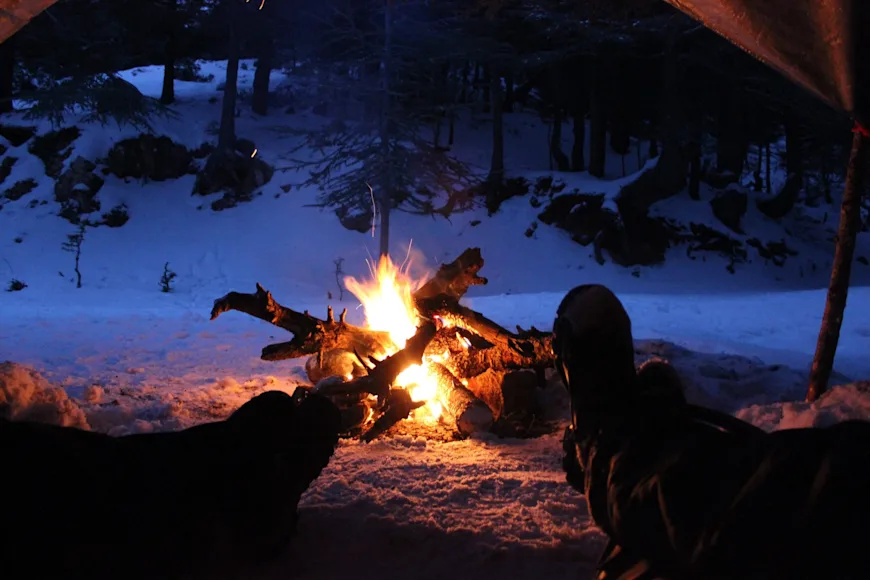_We may earn revenue from the products available on this page and participate in affiliate programs. Learn more ›
_
Do you need a 4-season tent for winter camping? Short answer: no, it isn’t necessary, but it is nice. In fact, you don’t need a tent at all if you are willing to build a snow shelter or something similar. For many beginner winter campers, it is a big investment to purchase a 4-season tent before knowing if winter camping is even an activity they enjoy. Our first recommendation is to borrow or rent a 4-season tent so you have ample protection against the elements and a chance to try a tent out before buying. Some outfitters eventually sell their used rentals, making this a great place to test a tent and then potentially buy a used one.
If you don’t have an outfitter to rent from or a friend to borrow from, another option is to learn how to winterize a 3-season tent that you already own. When done correctly or when the weather isn’t too cold and wet, camping in a 3-season tent during the winter is quite manageable. It does take a bit more gear and planning, but if you are winter camping for the first time, it is best to test it in easily accessible areas while car camping to be safe.
How to Winterize a 3-Season Tent
Use caution when camping during the winter season. Winter camping can be a very special, rewarding experience, but it can also be extremely dangerous and potentially deadly when the proper precautions are not taken. Learn more about camping safely in the winter on the National Park Service website.
Insulate and Minimize Ventilation
A standard 3-season tent will only be about 5 degrees warmer than the outdoor temperatures (F). Because of that, some insulating and minimizing of ventilation is in order. Most 3-season tents have quite a bit of ventilation because they are used during the summer and shoulder seasons. While all tents need some ventilation no matter the weather, having less will help trap more heat inside the tent.
A tarp or footprint for the ground is essential when camping in the winter, but if you have some extra tarps, they can help cover some of the ventilation. To do this, you can set up the tent as usual and then use a small tarp to protect the top before putting on the rain fly. Tarps can also be used to make wind blocks outside of the tent when necessary.
Most 4 season or expedition tents will have small ventilation areas to prevent condensation from accumulating in the tent. These are located on the top and bottom to encourage airflow through the tent. You can use a tarp for this, as mentioned earlier, or another option is to use a thermal blanket.
We always recommend a ground tarp, but in the winter, having more insulation on the floor is ideal. Keep in mind that we are looking at this from the lens of car camping, not backpacking or an expedition, so we expect that you can carry a bit more gear. So, while you’ve packed a few tarps, consider bringing an extra wool blanket large enough to cover the tent’s floor and two sleeping pads. One foam pad with an inflatable pad on top works well, or you can invest in a sleeping pad with an R-value high enough for the temperatures.
Insulating the walls may not be necessary for smaller tents, but depending on the weather, adding fabric or thermal blankets to the walls can trap even more heat inside. Get creative with it and see what works. A lot of it will come down to personal preferences and the weather conditions as to how to best insulate a 3-season tent for winter camping.
Waterproofing and Wind Protection
Beyond insulating the tent, it helps to protect yourself from winter weather and moisture. Depending on the quality of the construction and how old the tent is, it may need to have a waterproofing solution applied to it. Some more affordable tents also will skimp on a few things that help with waterproofing, like sealing the seams, so double-check the seams before you go.
Check out our other Gear Rx article on how to waterproof outdoor gear
to learn to apply waterproofing solutions.
To seal tent seams, use a product like Gear Aid Seam Grip
and follow the directions.
Once you get to camp, you can employ some wind protection. If you have extra tarps, you can use one of those as a windbreak as needed. Other options include building up snow to act as a natural break. Camp in areas with natural cover from trees, bushes, or rocks.
Even if you don’t always use them, learn to use your tent’s guylines during the winter. Guylines help keep the tent fabric tight, adding more wind resistance to your setup. Plus, if it snows, tight tent fabric makes it easier for the snow to slide off instead of accumulating on the tent, compromising the fabric’s waterproofing.
Depending on where you are camping, you may not have places to attach guylines or an easy way to use the factory tent stakes. Invest in winter-specific tent stakes like the MSR Blizzards
so you can stake out the tent anywhere you camp. These stakes only work in compacted snow, so pack the snow before setting up the tent. Burying tent corners or using other objects like rocks and logs can also work to tie down guylines.
Don’t Skimp on the Sleep Setup
The last thing you want is to be cold in your sleep. Even with the best expedition tent, you need to have appropriate sleeping gear and clothing to stay warm throughout the night.
Here are a few ways to stay warm while you sleep while winter camping:
Invest in, borrow, or rent a sleeping bag that is suitable for the temperatures
Double up on sleeping pads
Use a hot water bottle while sleeping
Pack extra base layers and socks to avoid sleeping in wet clothing
Use a tent-safe space heater for cold nights and mornings
My personal favorite: bring your husky to cuddle you through the night
Remember, to try winter camping for the first time, you don’t need to buy everything outright. Look into local programs, buy used gear, and ask friends and family if they have the equipment you can borrow.
FAQ
Q: Should I put a tarp under my tent?
Whether it is a tarp or a tent footprint, always use ground cover underneath the tent floor when winter camping. Especially if you need to set up on the snow, a tarp or footprint prevents moisture from seeping through the tent floor and can help protect the floor from any sharp or abrasive objects on the ground.
Q: How do you keep a tent warm under 30 degrees?
A four-season or winterized three-season tent should be well insulated and protected in 30-degree F weather conditions. Other things you can do to stay warm while winter camping includes getting a sleeping pad with a higher R-value, using a sleeping bag rated for the temperatures, sleeping with a hot water bottle or feet warmers, using a tent-safe space heater before bed and in the morning, and bring plenty of layers so you can change out of wet clothes before bed.
Q: How do you waterproof your tent?
Most tents come already waterproofed, but these waterproof coatings are not all created equal and will wear off with time. You can re-waterproof your tent and seal all seams before winter camping. Check out our other Gear Rx article on how to waterproof outdoor gear
to learn how.
Q: Is there a safe heater for a tent?
Yes, there are some tent safe heaters. Space heaters safe for tents tend to have auto shutoffs if they tip over, and potentially the most popular brand for camping is the Mr. Heater Big Buddy
. Be aware that with the limited ventilation within a tent, carbon monoxide poisoning is a risk
. We do not recommend running a propane heater all night, but they can be nice to heat up in the morning or while getting ready for bed. Small electric heaters can also be used but require an external power source.
Q: How much warmer is a tent than outside?
A non-winterized 3-season tent is usually only about 5 degrees F warmer than the outdoor temperatures. Winterized 3-season and 4-season tents will range from 10-20 degrees warmer, while specialty expedition or insulated tents could be up to 25 degrees F warmer than outside temperatures.


